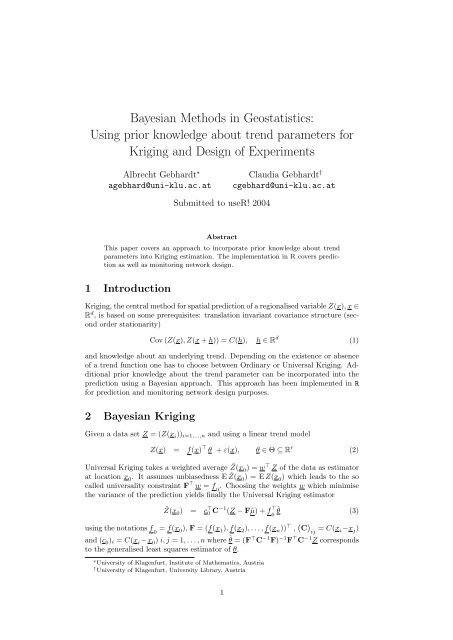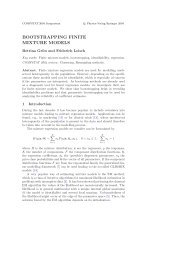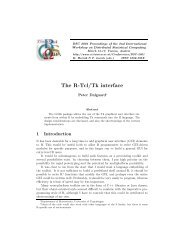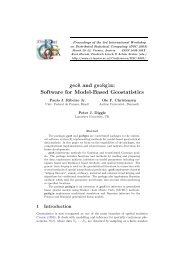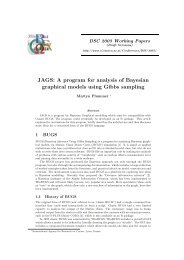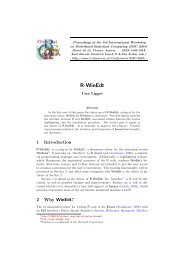Embedding R in Windows applications, and executing R remotely
Embedding R in Windows applications, and executing R remotely
Embedding R in Windows applications, and executing R remotely
Create successful ePaper yourself
Turn your PDF publications into a flip-book with our unique Google optimized e-Paper software.
Bayesian Methods <strong>in</strong> Geostatistics:<br />
Us<strong>in</strong>g prior knowledge about trend parameters for<br />
Krig<strong>in</strong>g <strong>and</strong> Design of Experiments<br />
Albrecht Gebhardt ∗<br />
agebhard@uni-klu.ac.at<br />
Claudia Gebhardt †<br />
cgebhard@uni-klu.ac.at<br />
Submitted to useR! 2004<br />
Abstract<br />
This paper covers an approach to <strong>in</strong>corporate prior knowledge about trend<br />
parameters <strong>in</strong>to Krig<strong>in</strong>g estimation. The implementation <strong>in</strong> R covers prediction<br />
as well as monitor<strong>in</strong>g network design.<br />
1 Introduction<br />
Krig<strong>in</strong>g, the central method for spatial prediction of a regionalised variable Z(x), x ∈<br />
R d , is based on some prerequisites: translation <strong>in</strong>variant covariance structure (second<br />
order stationarity)<br />
Cov (Z(x), Z(x + h)) = C(h), h ∈ R d (1)<br />
<strong>and</strong> knowledge about an underly<strong>in</strong>g trend. Depend<strong>in</strong>g on the existence or absence<br />
of a trend function one has to choose between Ord<strong>in</strong>ary or Universal Krig<strong>in</strong>g. Additional<br />
prior knowledge about the trend parameter can be <strong>in</strong>corporated <strong>in</strong>to the<br />
prediction us<strong>in</strong>g a Bayesian approach. This approach has been implemented <strong>in</strong> R<br />
for prediction <strong>and</strong> monitor<strong>in</strong>g network design purposes.<br />
2 Bayesian Krig<strong>in</strong>g<br />
Given a data set Z = (Z(x i )) i=1,...,n <strong>and</strong> us<strong>in</strong>g a l<strong>in</strong>ear trend model<br />
Z(x) = f(x) ⊤ θ + ε(x), θ ∈ Θ ⊆ R r (2)<br />
Universal Krig<strong>in</strong>g takes a weighted average Ẑ(x 0) = w ⊤ Z of the data as estimator<br />
at location x 0 . It assumes unbiasedness E Ẑ(x 0 ) = E Z(x 0 ) which leads to the so<br />
called universality constra<strong>in</strong>t F ⊤ w = f 0<br />
. Choos<strong>in</strong>g the weights w which m<strong>in</strong>imise<br />
the variance of the prediction yields f<strong>in</strong>ally the Universal Krig<strong>in</strong>g estimator<br />
Ẑ(x 0 ) = c ⊤ 0 C−1 (Z − Fˆµ) + f ⊤ ˆθ<br />
0<br />
(3)<br />
us<strong>in</strong>g the notations f 0<br />
= f(x 0 ), F = (f(x 1 ), f(x 2 ), . . . , f(x n )) ⊤ , ( C ) ij = C(x i −x j )<br />
<strong>and</strong> (c 0 ) i = C(x i −x 0 ) i, j = 1, . . . , n where ˆθ = (F ⊤ C −1 F) −1 F ⊤ C −1 Z corresponds<br />
to the generalised least squares estimator of θ.<br />
∗ University of Klagenfurt, Institute of Mathematics, Austria<br />
† University of Klagenfurt, University Library, Austria<br />
1


